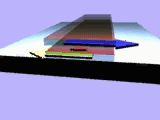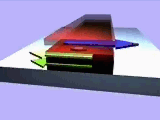The GMR-Effect
To
detect a giant
magnetoresistive effect
two ferromagnetic layers and a non -magnetic conductive intermediate metal
layer are needed. The resistance depends on the difference between the layer
magnetization angles. With a parallel magnetization arrangement in the ferromagnetic
layers a higher resistance is reached in contrast to an anti- parallel arrangement
of the magnetization directions.
There are
several types of GMR multilayers leading to different sensor designs, the
basic types will be described in the following:
Simple GMR Multilayers
The oldest type is the antiferromagnetically (AF) coupled multilayer. It consists of alternatingly ferromagnetic (f.e. NiFe or Co) and non magnetic layers(f.e. Cu or Ag), of which the thicknesses are chosen such that the exchange coupling between the magnetic layers is antiparallel.
An external
magnetic field will rotate all magnetization directions towards a parallel
configuration, and thus reduce the resistance. This effect is independent
of the direction of the magnetic field (neglecting anisotropy fields, which
are usually relatively small).
The rotation of the magnetization in a bilayer configuration will be shown
in the following video.

Magnetic
field
Magnetization1
Magnetization2
GMR-Spin
Valve Systems
In this kind of multilayer, the magnetization
direction of one ferromagnetic layer is pinned via the exchange biasing effect,
usually by an adjacent antiferromagnetic layer. The magnetization of the free
layer separated by a thin intermediate layer (f.e. Cu) from the pinned layer
is almost free to rotations induced by external magnetic fields.
![]() A
couple of new simulations of spinvalve - layers and spin valve based sensors
are available in the download
area.
A
couple of new simulations of spinvalve - layers and spin valve based sensors
are available in the download
area.
The magnetization rotations of a spin valve system in an extrenal field that
at the beginning grows up and then changes its direction are shown in the
following video

exchange
biased magnetization
Magnetization
1
Magnetization 2
extrenal magnetic field
Due to the free magnetization rotation in the second layer in contrast to the almost unmovable pinned magnetization in the biased layer, the resistance of the multilayer predominantely depends on the angle of the external field. Angle detection sensors are therefore preferable to construct.
Further informations are available under articles.